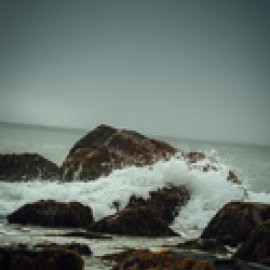RESCUE, part 7: Policy that Works
-
English
-
ListenPause
intro music
Welcome to World Ocean Radio…
I’m Peter Neill, Director of the World Ocean Observatory.
Policy in action is policy that works. And despite frustration over larger initiatives and critical progress, there are examples that have been funded and fostered through the United Nations structure, other governmental, public and private agencies. To alleviate any litany of failure in these editions, perhaps it is useful to feature some successes as harbingers of what is possible and what will be further achieved in the future.
The most ambitious of international policy goals for the ocean is the resolve to protect 30% of the global ocean by 2030. [see #30by2030] Consider that the ocean covers 70% of the planet’s surface, According to the Marine Conservation Institute, some 7% of the world’s ocean is covered by some form of marine protection. However, only 2.7% is covered by what the institute describes as ‘full or highly protected’ areas. Marine Protected Areas are typically defined and designated by a national government within its exclusive economic zone, up to 200 miles offshore, a collective area that includes special marine habitats such as mangroves and salt marshes wherein an enormous wealth of biodiversity is concentrated and vulnerable to coastwise development and other threats to vitality and viability.
There are over 400 marine protected areas in the world, in some 65 countries – in the United States, the Mediterranean, through the Pacific Ocean islands, and Australia and New Zealand. Antarctica, by treaty is a de facto marine protected area, Although designated, they remain constantly under threat, susceptible to pollution, illegal fishing, military incursions, nuclear testing, chemical waste disposal, mining, bottom trawling, and more. Their borders are invisible, there can be no protection against circulation and other transported threats, and their management and enforcement capacity are often so limited that some are called “paper parks” in that they have no real surveillance or protection at all. But they are the beginning of a structure, an environmental and political demonstration of feasibility, and they lie at the heart of the 30 X 2030 ocean protection movement and provide a sense of possibility and hope for more comprehensive ocean conservation.
Other successes are less legislative, but more socially successful through enabled conservation values to build capacity and invent and apply new conservation practice. For example, according to the Global Environment Facility (GEF), one of its most successful investments was the reversal of the hypoxic zone created in the Danube and Black Sea region where fertilizer run-off, industrial and domestic waste had created a dead zone that destroyed aquatic life and collapsed local fish stocks with catastrophic social and financial losses. The GEF, the UN Development Program, and the World Bank invested over $350 million in policy guidance and incentivized alternatives and reforms: reducing pollutants, revising planning standards, applying new technology for water treatment and waste disposal, modifying or drafting legislation, uniting conflicted interests and regional authorities, rebuilding ecosystems, and revitalizing an oxygen-starved dead zone into a rehabilitated, value restored natural area. It took twenty years.
Marine protected areas and coastal transformation are obvious tools to accelerate the process, to meet the goal, to make the difference. They exemplify policy that works. There are others, and we have them in our policy portfolio, waiting. I was once given a replica of an ax found at L’Anse aux Meadows, the Viking settlement in Newfoundland, that dates to about 1030, ten centuries ago. Those settlers survived by living with the land and on the sea. My ax is both a fact, a potential for action, and an artifact, shaped by a human hand. The Vikings did not poison their shelter. They left marks of hard, but successful living in the earth and alongshore. My ax, then, is a metaphorical, magical tool, but it is only as good as the woman or man who wields it with wisdom and purpose. If we have the tools, if we have the funds, if we have the will, we had best get quickly started. 2030 is only seven years from now. Surely, we need a plan: RESCUE:
R for renewal;
E for environment;
S for society;
C for collaboration;
U for understanding; and
E for engagement.We will discuss these issues, and more, in future editions of World Ocean Radio.
outro music
This week we continue the multi-part RESCUE series by featuring some successful initiatives and ocean progress, with examples of policies related to Marine Protected Areas that are working and thriving. RESCUE as an acronym offers a plan for specific action and public participation: Renewal, Environment, Society, Collaboration, Understanding, and Engagement.
About World Ocean Radio
5-minute weekly insights dive into ocean science, advocacy and education hosted by Peter Neill, lifelong ocean advocate and maritime expert. Episodes offer perspectives on global ocean issues and viable solutions, and celebrate exemplary projects. Available for syndicated use at no cost by college and community radio stations worldwide.
Image
Photo by Tim Foster on Unsplash
@timberfoster
- Login to post comments



